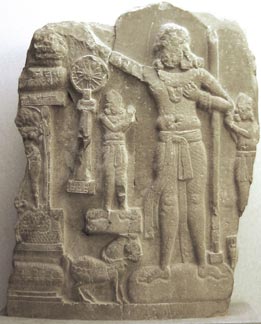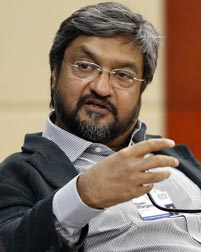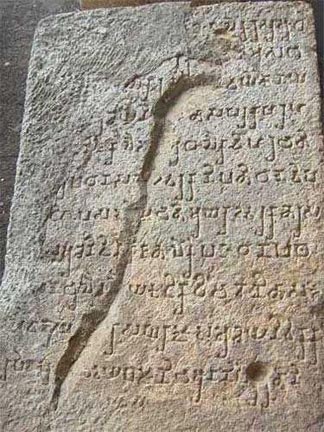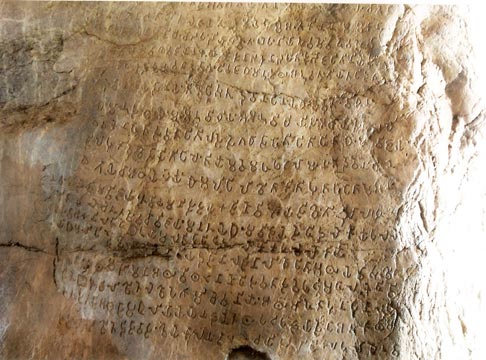|

Emperor Ashoka at Amaravati, Andhra Pradesh preseved at
Guimet Museum |
Ashoka's recipe for reconciliation
by B.C. Sharma
Given the repeated use of the term 'reconciliation' in Sri Lanka's
post-war context, one is liable to get the impression that it is a new
concept evolved to address the ethnic situation in the island. But
reconciliation is needed not only in Sri Lanka but in all countries
facing conflict and the many troubles created by conflict, especially
prolonged conflict.
In fact, the need for reconciliation was felt in the distant past
also.
One of the first rulers to attempt reconciliation and build an
inclusive society comprising diverse peoples was the great Indian
Emperor Ashoka (269 -232 BC).
Ashoka's seminal contribution to the ideology of reconciliation and
an inclusive society was highlighted by Prof.Rajeev Bhargava, Director
for the Delhi-based Centre for the Study of Developing Societies, at a
lecture delivered in Colombo on July 5.
It was Ashoka's singularly bloody military campaign to annex the
Eastern Indian region of Kalinga in 262-261 BC (100,000 people perished
in it) which made him turn to Buddhism and its message of peace,
non-violence and tolerance. While the war might have been the immediate
trigger for his conversion and adoption of a totally new way of life and
a new philosophy of governance, various kinds of conflicts in the India
of Ashoka's time also had a major role to play in bringing about change.
|

Prof.Rajeev Bhargava |
In his 1925 work 'Ashoka' D. R. Bhandarkar says that in Ashoka's
time, there was a lot of wrangling by competing religious groups.
"Religious fanaticism and sectarianism was rampant," Bhandarkar wrote.
According to historian Romila Thapar, there was the "uncompromising
materialism" of the Charvakas, the metaphysical subtleties of the
Upanishadic thinkers, and of course the multi-layered and complex
ritualism of the Vedic Brahmins.
Rituals and sacrifices
Religion in pre-Buddhist India was dominated by the Vedas. The Vedas
were essentially about rituals and sacrifices meant to increase the
wealth and happiness of the two top castes in the Hindu caste hierarchy,
namely, the Brahmins (ritual specialists ) and Kashtriyas (the ruling
class). The boons sought by the Kshatriyas were quintessentially 'this
worldly' and not 'other worldly'. As for the Brahmins, they held the key
to happiness as only they knew how to conduct the increasingly complex
rituals and sacrifices.
Of course, there was an 'other worldly' aspect to the rituals, but
the 'other worlds' of the Vedas and 'this world' were not independent of
each other. They were part of a single cosmos. In other words, Loka,
Swargaloka and Narakaloka were all part of the same cosmos. Even the
Gods transited between Loka and Swargaloka. One of the goals of the
Vedic rituals was to become 'Amartya' or immortal, which is very
different from wanting to attain the Upanishadic 'Moksha' which is
release from life anywhere.
Apart from those who believed in this Vedic religion, there were
sects which held as being undesirable, acquisition of wealth and other
forms of worldly happiness through rituals and sacrifices. The sect of
Munis believed that salvation would come from self-abnegation,
withdrawal from society and performance of exacting and severe
practices.
The third system of thought was the Upanishadic one. The Upanishads
distinguish between the world (samsara) and Brahman or Atman (the
Ultimate Reality embedded in the universe or in one's inner imperishable
self). The knowledge of the Brahman comes by a search for Gnana
(knowledge) through intellectual exertion. In the Chhandogya Upanishad,
it is clearly stated that rituals and sacrifices or self-abnegation and
self-mortification are useless for attaining Moksha or True Immortality.
Prof. Bhargava says that the Upanishads provide the "axial turn" in
Indian civilization. But still, he notes that the goals of Vedic rituals
and Upanishadic search for the knowledge of the Brahman and attainment
of Moksha are "individualistic" and have nothing to do with "other human
beings or living creatures."
Buddha's Contribution
It was the Buddha who bought in the "inter-personal" element into the
concept of Dharma or good conduct, says Prof. Bhargava. The Buddha even
extended the inter-personal to the animal world. His Dharma was 'social'
inasmuch as it had to do with how people treated each other and treated
animals and other living beings.
|

Rock Edict in Dhauli, Odisha, Eastern India |
With the coming of Buddhism, there was a need for public or political
morality, Bhargava observes. The necessity to have systems to arbitrate
between multiple, radically different and rival conceptions had arisen
as society began to advance and diversify as a result of trade and other
interactions with the world. Ashoka's edicts give the recipe for
reconciliation of these divergent tendencies so that they can interact
and mutate each other and in that process contribute to peace,
understanding and growth. Jawaharlal Nehru's concept of 'unity in
diversity' as the goal for India, had its roots embedded in Ashoka's
ideology. It was with a view to establishing his social Dharma that
Ashoka put up rock edicts in thirty places in what is now India, Nepal,
Bangladesh, Pakistan and Afghanistan. And they were written in various
local scripts like Prakrit, Sanskrit, and even Greek and Aramaic. The
language was not flowery and formal but simple and direct so that the
masses might understand. It was the beginning of mass communication as
we understand it today.
"At the core of these edicts are a set of precepts about how to lead
a good individual and collective life," Bharagava said. Ashoka took into
consideration and accommodated two realties. One reality was that people
want uniformity in thought, word and deed.
The second reality was the fact of societies being composed of
diverse elements often contradicting and conflicting with each other. He
recognized that diversity was in the nature of things and could not be
wished away not could one wish away the feeling of security provided by
uniformity and sameness. But Ashoka's vision was to see a society that
accommodated diversity because he believed that diversity and mutual
interaction were necessary for the whole society as well as its
constituent parts.
In Edict 7, for example, Ashoka says that all 'Pasandas' (members of
various sects) should dwell everywhere in his empire. He particularly
wanted the leaders of the Pasandas to move about in the empire,
espousing their respective doctrines. This Ashoka did in the context of
sects being persecuted and even expelled en masse in something like
modern ethnic cleansing. He wanted tolerance to be built through
interaction under State patronage. He did not believe in uniformity and
homogenization but in diversity and coexistence based on a true
understanding founded on interaction and discussion. In other words,
Ashoka evolved a new "public morality" based on mutual interaction,
which was, at once, for individual and common good.
Respective doctrines
According to Bhargava, Edict 7 was an attempt to curb the then common
practice among Kings to dispense justice as per their own personal
interest and make them think in terms of the common good, as per a
Dharma which was an 'mmutable moral principle above the King'. The
enlightened King was called a 'Charavarti' in which the Chakra or Wheel
represented the Wheel of Dharma.
|

Rock Edict in Kalsi in Dehra Dun district Uttarakhand, India |
However, Ashoka was not oblivious to the common man's need for
rituals. Edict 9 allows rituals and ceremonies on occasions like birth,
marriage, ahead of journeys, sickness and death. But it was his desire
to substitute rituals for the good of man, by State welfare measures. He
urged Kings to dig wells, build rest houses, plant trees and arrange for
the cultivation of medicinal herbs.
"Ashoka said that the Dhammika Dhammaraja must not only be concerned
with upholding the property and family rights of people in society, but
go beyond these minimum obligations and ensure that everyone's basic
needs are met," Bhargava says.
For Ashoka, the 'ceremonies' of Dharma (Dharma Mangalas), are the
proper treatment of slaves and employees, restraint in violence towards
living creatures, and reverence to teachers, Brahmins and ascetics.
To bring the various sects or Pasandas to a meeting point, Edict 12
says that the essentials of all faiths are the same and these essentials
are the common ground for them to meet.
Restrained Speech
For Ashoka, one of the essentials of Dharma is Vachaguti (restraint
on speech) and this is emphasized in Edict 12. He put great emphasis on
right speech because in the oral culture of his day, what was said and
how it was said, could do or undo a relationship for what was uttered
could not be withdrawn. "Words can be a weapon or an elixir. They can
soothe or cause grievous hurt." Bhargava observes that even in this day
and age, speech or oral communication plays a huge role in inter
personal and social communication and well being.
Ashoka says that speech that is critical of others may be freely
made, but only if we have good reasons to make the criticism. Even then,
one's views must be uttered only on appropriate occasions. A critique
must not be done with a view to humiliating others. Edict 12 also
cautions against boasting about one's sect.
According to Ashoka, uncritical and effulgent praise of one's own
sect, can only damage that sect. By offending and thereby estranging
others, one's own Pasanda loses its capacity for mutual interaction and
for changing in a desirable direction, he argues.
Ashoka also emphasizes the need for Bhaava Shuddhi (self
purification). Bhargava interprets this as a call for abjuring ill will
towards others and not just purification of oneself.
To foster interaction and understanding, Ashoka urged the people of
various sects to meet frequently in an assembly or concourse. Underlying
this advice is Ashoka's belief that the ethical foundations of the
various sects are not static but constantly evolving. According to him,
the growth of the sects is crucially dependent on mutual communication
and dialogue with one another rather than existing in isolation. |

